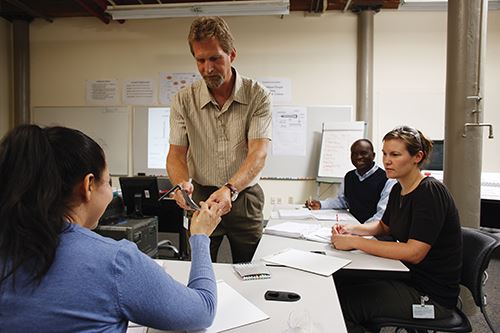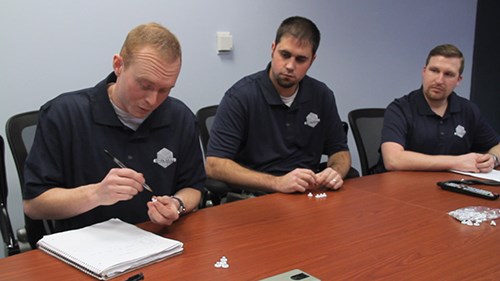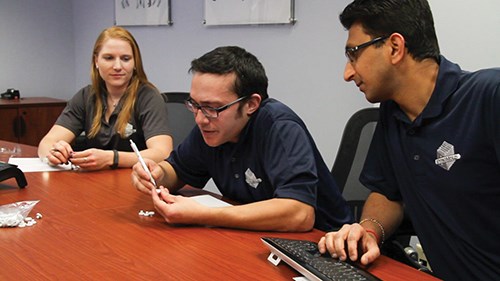The Three Ts of "Growing Your Own"
It takes a team, tours and training to develop a feeder system that attracts and keeps a young talent pool.
“We grow our own.” That’s how management at NyproMold Inc.. NyproMold says it finds and keeps its young talent, although the company has no written strategy for recruiting future moldmakers. What’s unique about this common philosophy is NyproMold’s feeder system, which ensures that a steady stream of young, solid candidates is available from within the company. Exactly how this system was built can be described as both by common sense and complicated, but one thing is for sure: It took commitment and passion. And the results NyproMold continues to reap are proof that it works.
Here, Rich Stueber, mold design manager for Gurnee, Illinois-based NyproMold shares a simplified checklist of the steps his company takes to attract and retain its young talent, including six under-35 team members featured in our Moldmaking Matters: Your Career Can Make a Difference recruitment video (see sidebar).
Build a team. The responsibility for employee recruitment and retention falls to a team of four department heads from engineering, machining, EDM and scheduling/outsourcing as well as the general manager of the facility. This team, which works together to select qualified candidates for employment, meets regularly with the overall goal of ensuring that all the company’s manufacturing needs are met so that it can fulfill its objectives and goals. Multiple team members interview each potential employee over several visits. “The three main qualities we look for in new recruits are responsibility, work ethic and mechanical ability,” Stueber says. Team members also test candidates on trade-related math, blueprint reading, machining knowledge and common-sense scenarios. The final decision on who to hire is made as a team.
Immerse the team in the community. The NyproMold feeder system begins with the team’s heavy involvement in the local community educational system. Team members exhibit at job fairs to promote manufacturing to students and their parents. Using these opportunities to show parents that manufacturing is “not what it used to be” can have a huge impact, Stueber says. The team members try to dispel some of the common myths about manufacturing, including that it consists of low-skill, low-paying, manual work in dark, dirty and dangerous environments making meaningless products. In reality, manufacturing can offer lucrative careers in highly skilled positions at good pay and with excellent benefits; in a nurturing culture; surrounded by automated equipment in a bright, clean environment; and making potentially life-saving products.
NyproMold’s team members also teach at the college level, where they can directly connect with students and help promote the industry. Several volunteer on a college committee that is working to bring back high-school-level vocational training in which students would come to the college during the school day to learn about and use machining equipment.
“We try to encourage talented people at the high school and college levels who may not have the desire or funding to go to a university,” Stueber says. “Currently, I teach a 16-week class at a local college during the spring and fall semesters, and the class is always at capacity.”
Educate and expose to technology. Seeing is believing for this next generation of workers, so the No. 1 strategy for attracting kids to manufacturing is showing them new technology in action. “The next generation is intrigued with computer technology, running CNCs and three- to five-axis machines,” Stueber says. NyproMold is able to offer access to this high technology with its investments in cutting-edge processes such as CT scanning and laser sintering. Facility tours are essential.
This is also why NyproMold donates old mold-building machinery to vocational schools instead of selling it in the used-machine market. When the company needs to replace machinery, its first consideration is whether a local college could benefit from acquiring the existing equipment. It has donated several machines that currently are being used by both high school and college students. NyproMold also trains the teachers and students to use the equipment. This establishes relationships that often lead to new interns for the company who may eventually become employees, according to Stueber.
Continue to train. Today’s mold manufacturers need to provide a culture of growth. Growth opportunity has a huge influence on decision-making by the next generation of skilled workers, and that growth requires training. At NyproMold, this includes on-the-floor work and classroom time.
Every apprentice at the company starts by working with a seasoned moldmaker who holds him or her accountable for growing within this position. Cross-training is also emphasized. “The goal is to get people where they want to be,” Stueber says. “To that end, once hired as an apprentice, if he or she displays a talent or expresses a desire to be in a certain area, provisions are made to accommodate.”
NyproMold also provides financial assistance to students who achieve passing grades in college-level classes in applied math, blueprint reading, machining principles, machine shop, CNC, grinding, and geometric dimensioning and tolerancing (GD&T).
Recruiting and retaining that next generation of skilled manufacturing workers involves getting students interested in the trade, working with them through an internship, providing excellent benefits, helping them continue with trade-related schooling, employing them within a manufacturing team, creating a clear career pathway, offering personal support for individual growth, and training them to become lead moldmakers who will one day bring up apprentices themselves. That is the ultimate feeder system.
Related Content
Making Quick and Easy Kaizen Work for Your Shop
Within each person is unlimited creative potential to improve shop operations.
Read MoreThe Trifecta of Competitive Toolmaking
Process, technology and people form the foundations of the business philosophy in place at Eifel Mold & Engineering.
Read MoreLeading Mold Manufacturers Share Best Practices for Improving Efficiency
Precise Tooling Solutions, X-Cell Tool and Mold, M&M Tool and Mold, Ameritech Die & Mold, and Cavalier Tool & Manufacturing, sit down for a fast-paced Q&A focused on strategies for improving efficiencies across their operations.
Read MoreTop 10 Topics to Cover During an ISO 9001 Manufacturing Audit
Take a look at this practical hands-on approach to conducting a quality audit.
Read MoreRead Next
Reasons to Use Fiber Lasers for Mold Cleaning
Fiber lasers offer a simplicity, speed, control and portability, minimizing mold cleaning risks.
Read MoreHow to Use Strategic Planning Tools, Data to Manage the Human Side of Business
Q&A with Marion Wells, MMT EAB member and founder of Human Asset Management.
Read MoreAre You a Moldmaker Considering 3D Printing? Consider the 3D Printing Workshop at NPE2024
Presentations will cover 3D printing for mold tooling, material innovation, product development, bridge production and full-scale, high-volume additive manufacturing.
Read More


























